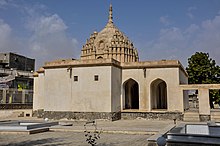You can help expand this article with text translated from the corresponding article in Persian. (November 2023)Click [show] for important translation instructions.
|
| Vishnu Temple | |
|---|---|
 A view of Temple | |
| Religion | |
| Affiliation | Hinduism |
| District | Bandar Abbas |
| Deity | Vishnu |
| Location | |
| Country | Iran |
| Geographic coordinates | 27°10′52″N56°15′51″E / 27.1810756°N 56.2641°E |
The Vishnu Temple in Bandar Abbas, Iran is a historical monument constructed in 1892 (1310 A.H.) during the reign of Mohammad Hassan Khan Sa'd-ol-Malek and dedicated to the Hindu god Vishnu. [1] [2]
Contents
The temple was built by the Indian community working for the British East India Company. [3]




